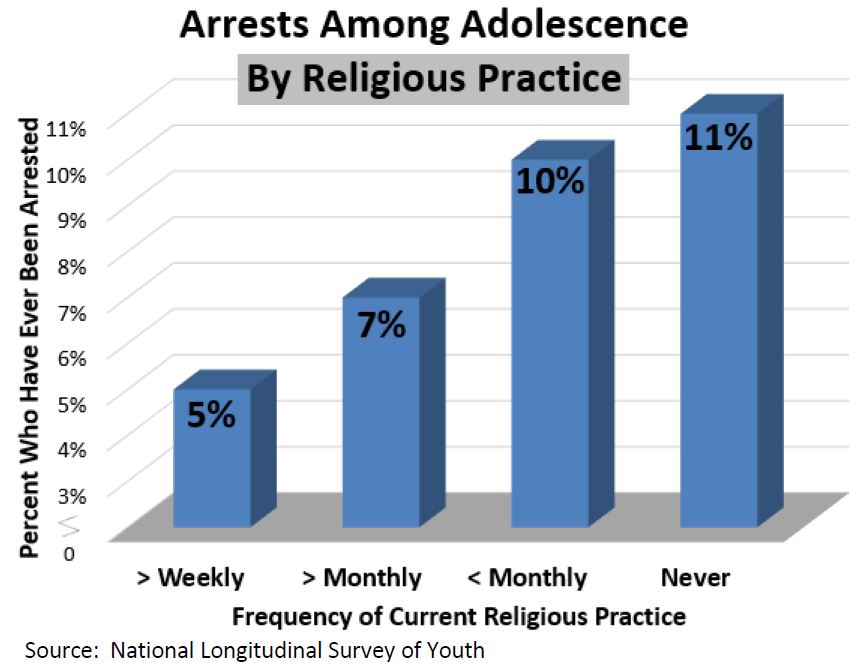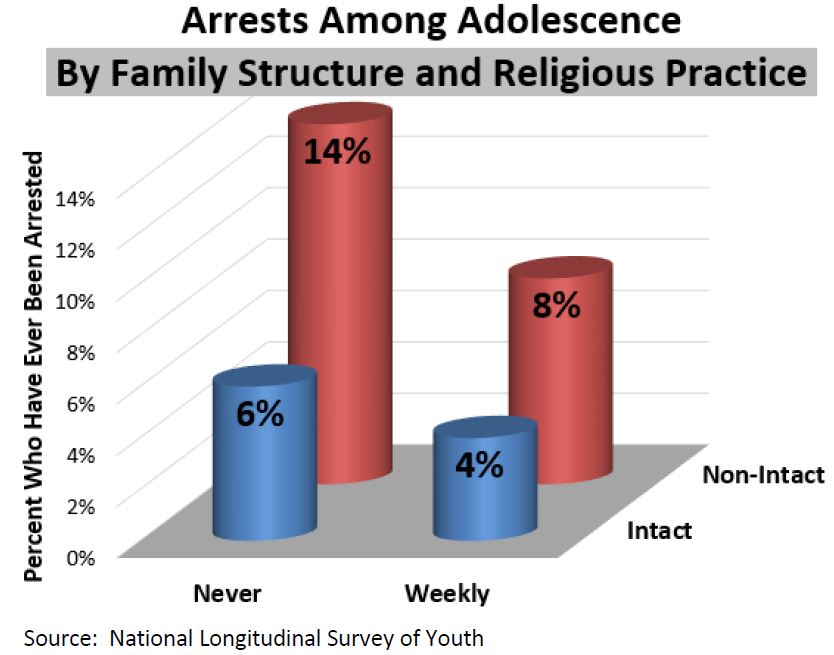Click Here to download “Arrests Among Adolescents by Family Structure and Religious Practice”
Arrests Among Adolescents by Family Structure and Religious Practice
The 1997 National Longitudinal Survey of Youth shows that youths who did not grow up in always-intact married families and never attended church were most likely to have “ever been arrested”. [1] Family Structure: Only 5 percent of youths who grew up in an intact married family had ever been arrested, followed by youths from married stepfamilies and families with intact cohabiting partners (8 percent), single divorced parent families (9 percent) and cohabiting stepfamilies and always single parent families (13 percent). Religious Practice: Five percent of youths who attended weekly religious services at the time of the survey had ever been arrested, followed by those who attended one to three times a month (7 percent), those who attended less than once a month (10 percent), and those who never attended church (11 percent).
Religious Practice: Five percent of youths who attended weekly religious services at the time of the survey had ever been arrested, followed by those who attended one to three times a month (7 percent), those who attended less than once a month (10 percent), and those who never attended church (11 percent).
 Family Structure and Religious Practice Combined: Only 4 percent of youths who attended weekly religious services at the time of the survey and who grew up in an always-intact family had ever been arrested, followed by youths who never attended church but grew up in an always intact family (6 percent), those who grew up in all other family structures but attended church weekly (8 percent) and those who never attended church and grew up in all other family structures (14 percent).
Family Structure and Religious Practice Combined: Only 4 percent of youths who attended weekly religious services at the time of the survey and who grew up in an always-intact family had ever been arrested, followed by youths who never attended church but grew up in an always intact family (6 percent), those who grew up in all other family structures but attended church weekly (8 percent) and those who never attended church and grew up in all other family structures (14 percent).
 Related Insights from Other Studies: The effects of family structure can be seen in the Oregon Youth Study, a longitudinal survey. Compared to boys living with both biological parents, boys living in single-mother households had higher odds of being arrested by age 14 (208 percent higher) and of being arrested by age 17 (128 percent higher). This survey also showed that boys living in stepfamilies had greater odds of being arrested by age 14 (210 percent higher) and of being arrested by age 17 (139 percent higher) than did boys in households with both biological parents.[2]
[1] These charts draw on data collected by the National Longitudinal Survey of Youth (1997).
[2] Coughlin, Chris and Samuel Vuchinich, “Family Experience in Preadolescence and the Development of Male Delinquency,” Journal of Marriage and the Family 58(2) 1996, pp. 491-501.]]>
Related Insights from Other Studies: The effects of family structure can be seen in the Oregon Youth Study, a longitudinal survey. Compared to boys living with both biological parents, boys living in single-mother households had higher odds of being arrested by age 14 (208 percent higher) and of being arrested by age 17 (128 percent higher). This survey also showed that boys living in stepfamilies had greater odds of being arrested by age 14 (210 percent higher) and of being arrested by age 17 (139 percent higher) than did boys in households with both biological parents.[2]
[1] These charts draw on data collected by the National Longitudinal Survey of Youth (1997).
[2] Coughlin, Chris and Samuel Vuchinich, “Family Experience in Preadolescence and the Development of Male Delinquency,” Journal of Marriage and the Family 58(2) 1996, pp. 491-501.]]>
